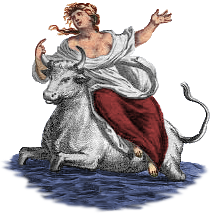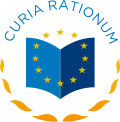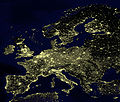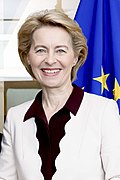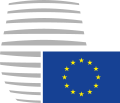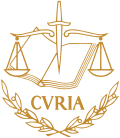Portal:European Union
Introduction
The European Union (EU) is a supranational political and economic union of 27 member states that are located primarily in Europe. The union has a total area of 4,233,255 km2 (1,634,469 sq mi) and an estimated population of over 450 million as of 2025. The EU is often described as a sui generis political entity combining characteristics of both a federation and a confederation. Containing 5.5% of the world population in 2023, EU member states generated a nominal gross domestic product (GDP) of around €17.935 trillion in 2024, accounting for approximately one sixth of global economic output. Its cornerstone, the Customs Union, paved the way to establishing an internal single market based on standardised legal framework and legislation that applies in all member states in those matters, and only those matters, where the states have agreed to act as one. EU policies aim to ensure the free movement of people, goods, services and capital within the internal market; enact legislation in justice and home affairs; and maintain common policies on trade, agriculture, fisheries and regional development. Passport controls have been abolished for travel within the Schengen Area. The eurozone is a group composed of the 20 EU member states that have fully implemented the EU's economic and monetary union and use the euro currency. Through the Common Foreign and Security Policy, the union has developed a role in external relations and defence. It maintains permanent diplomatic missions throughout the world and represents itself at the United Nations, the World Trade Organization, the G7 and the G20. In 2012, the EU was awarded the Nobel Peace Prize. In 2020, the United Kingdom became the only member state to leave the EU; ten countries are aspiring or negotiating to join it. (Full article...) Selected article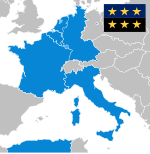 The ECSC was first proposed by French foreign minister Robert Schuman on 9 May 1950 as a way to prevent further war between France and Germany. He declared his aim was to 'make war not only unthinkable but materially impossible.' The means to do so, Europe's first supranational Community, was formally established in 1951 by the Treaty of Paris, signed not only by France and West Germany, but also by Italy and the three Benelux states: Belgium, Luxembourg and the Netherlands. Between these states the ECSC would create a common market for coal and steel. The ECSC was governed by a 'High Authority', checked by bodies representing governments, MPs and an independent judiciary. The ECSC was joined by two other similar communities in 1957, with whom it shared its membership and some institutions. In 1969 all its institutions were merged with that of the European Economic Community (EEC, which later became part of the European Union), but it retained its own independent identity. However in 2002 the Treaty of Paris expired, and with no desire to renew the treaty, all the ECSC activities and resources were absorbed by the European Community. During its existence, the ECSC had succeeded in creating a common market but could not prevent the decline of the coal and steel industries. It did however set the ground for the future European Union. Selected picturePhotograph: Julian Herzog Christiansborg Palace is a building in the Danish capital, Copenhagen. It is the seat of the Danish Parliament, the Office of the Prime Minister, and the Supreme Court. The first castle on the site was Absalon's Castle, built in 1167 by the bishop Absalon and demolished in 1370, after King Valdemar was defeated by the Hanseatic League. By the end of the 14th century Copenhagen Castle was built on the site but that too was demolished in 1731. The first Christiansborg was then built, on the orders of King Christian VI, becoming the largest palace in northern Europe on its completion in 1745. It was destroyed in 1794 by fire, and replaced by the second Christiansborg. That too burned down in 1884, eventually being replaced by the current building, which was built between 1907 and 1928. The modern building is neo-Baroque in style, although the 19th-century neoclassical chapel and the original Baroque riding grounds remain, having survived the fires.
Did you know?...that "Nocturne" is the Eurovision Song Contest winner with the fewest words, the Norwegian language original having only 25?  ...that the Eastgate Clock (pictured) in Chester is the second most photographed timepiece in the United Kingdom, after Big Ben? ...that "Kinek mondjam el vétkeimet?" received three perfect scores at the start of voting in the Eurovision Song Contest 1994 before ultimately coming in fourth, making Hungary the only debuting nation to lead the voting? Selected cityNicosia, known locally as Lefkosia is the capital and largest city of Cyprus. Nicosia is located at 35°10' north, 33°21' east (35.1667, 33.35). Located on the Pedieos river and situated roughly in the centre of the island, it is the seat of government as well as the main business centre. Nicosia is the center and capital of an administrative district (Nicosia District), and after the fall of the Berlin Wall, it is currently the only divided capital city in the world, with the northern (Turkish) and southern (Greek) portions divided by the "Green Line", a demilitarized zone maintained by the United Nations. The 1974 Turkish invasion and occupation of 36 percent of the island's territory literally cut the capital in half. The population of the part of the city under the control of the Republic of Cyprus is 206,200 (end of 2001). Nicosia is a modern, dynamic capital with lots of shops, restaurants and entertainment.The city is a trade center and manufactures textiles, leather, pottery, plastic, and other products. Copper mines are nearby. Nicosia is the seat of the University of Cyprus (UCY) and of all the colleges and institutes of Republic of Cyprus. General imagesThe following are images from various European Union-related articles on Wikipedia.
TopicsFeatured contentFeatured articles
Featured lists
Featured contentGood articles
CategoriesRelated portalsAssociated WikimediaThe following Wikimedia Foundation sister projects provide more on this subject:
Discover Wikipedia using portals |



